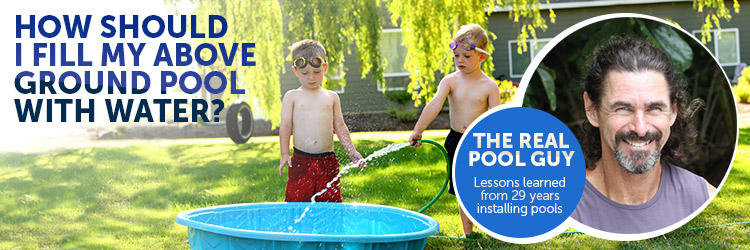So you’re finally getting that swimming pool. You’ve figured out which above ground pool to buy, how big it will be, and where it is going to be placed in your yard. You have an installer lined up (or have talked some really good friends into helping you install it), the date is set and you’re ready to go. But what about the water? Where is all that water going to come from in order to fill your swimming pool?
To a pool guy like me, the answer on how best to fill a pool is usually obvious, but I get asked this question all the time under all types of circumstances. To my surprise, over the years I’ve come across many scenarios where the answer isn’t so obvious. Generally, there are five options for filling an above ground swimming pool. For some all five options are viable. However, for some only two options are viable and some have only one viable option. If you have only one option then this decision will be easy. If you have more than one viable option, let’s weigh them up together. Shall we?
Generally, there are five options for filling an above ground swimming pool. For some all five options are viable. However, for some only two options are viable and some have only one viable option. If you have only one option then this decision will be easy. If you have more than one viable option, let’s weigh them up together. Shall we?
The Five Options for Filling an Above Ground Pool
- City or municipal water from your house
Most people now have access to municipal water at their homes. Some homes have septic tanks for their used water and some have to pay for municipal sewage. It is cool if you have a septic tank, because the water company will only charge you for the water to fill your pool. If you have municipal sewage, it can be expensive to fill your pool as you will be charged the sewage fee for all those gallons of water that the pool took to fill up. Money saving tip: Call your water company and tell them you are planning to fill a pool. They may give you a discount on the sewage or not charge for it at all.
City/municipal water is excellent for filling swimming pools, because the water is already treated and balanced.
- Well water directly from your well
Many homes out in the country don’t get municipal water and only have a well. This is not a problem as long as the quality of the well water is good. If your well water is not that good (meaning it’s smelly, cloudy or discolored) it’s still OK, but you’ll have to treat the water in the pool to get it clear and healthy. It will cost you more because you’ll have to get chemicals and it can take a few days to clear up.
- Well water coming through a softener system
Most homes that have only wells will have a water softening system attached somewhere. Running between 10 000 and 20 000 gallons through a softener has a cost as it will take a good amount of salt and chemicals to do so.
- Water from a delivery service
This is a nice option, but is usually too expensive for new pool owners. Here in Central Florida there are two guys that offer this service. One guy charges $500.00 for 9 000 gallons and the other guy charges $275.00 for 6 000 gallons. The water quality is always excellent and the pool gets filled really fast. So, it’s a good option, but it is pricey. Also, water delivery services are rare so chances are that you will not have this option anyway.Sometimes there can be issues with filling an above ground this quickly. If the liner is set too tightly or if it’s a beaded liner, it could come out of the bead channel. Keep an eye on things when filling a pool this fast.
- Water from the fire department
Long ago it seems in places far, far away, fire departments kindly used to fill swimming pools. This is now a rare occurrence in most areas, although some still do it usually for a donation or something. This method fills the pool fast too, so keep an eye on the liner while filling your pool.
Expensive Municipal Water Versus Cheap Well Water
A lot of homes have access to both municipal water and a well. If this is the case, do you fill the pool with municipal water that you have to pay for or do you fill it with your well water that’s free? The answer depends mainly on the quality of your well water. If your well water is completely clear, use it. You may have to shock it a little more initially and adjust the chemistry, but it’ll be much less expensive.
If your well water is just OK (meaning it’s a little cloudy and has a bit of an odor), you still may want to fill your pool with it. Certainly this water will take some extra start-up chemicals to get it right, but it’ll still be more cost-effective than filling it with municipal water.
Some other considerations are the condition of your well and its pump. Do you have issues with your well’s pump? Do you feel it’s on its last leg and you have to give it a break often? How about your well? Does it kick up a lot of sand or start to pump really slowly after a while of continuous use? Am I asking too many questions in one paragraph? A pool needs many gallons of water and if you are having issues like this, it may be better just to fill it with your municipal water.
What to Do While the Pool Gets Filled and What to Do Afterwards
Keep an eye on your pool while it is filling up. Make sure the liner isn’t coming loose and that there’s no moisture anywhere around the pool. Also, make sure that you install all of the top rails of the pool and connectors before the pool is more than halfway full. It can be much harder to install these parts after the pool has been filled.
You can take a water sample to a pool store so that they can analyze it and you can get the chemicals it needs for the start-up. You can shock the pool when it’s at least half full, but I would wait until it’s completely full because you can then turn on the pump and run the filter.













Leave a Reply